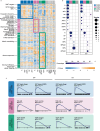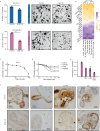Enterocyte-like differentiation defines metabolic gene signatures of CMS3 colorectal cancers and provides therapeutic vulnerability
- PMID: 39747069
- PMCID: PMC11696116
- DOI: 10.1038/s41467-024-55574-3
Enterocyte-like differentiation defines metabolic gene signatures of CMS3 colorectal cancers and provides therapeutic vulnerability
Abstract
Colorectal cancer (CRC) is stratified into four consensus molecular subtypes (CMS1-4). CMS3 represents the metabolic subtype, but its wiring remains largely undefined. To identify the underlying tumorigenesis of CMS3, organoids derived from 16 genetically engineered mouse models are analyzed. Upon in vitro Cre-recombinase activation, transformation is established and transcriptional profiling reveals that distinct CMSs (CMS2-4) are modeled with different organoids. CMS3-like, metabolic signature-positive, organoids are induced by KRAS mutations. Interestingly, metabolic signatures are subsequently shown to result from enterocyte-like differentiation both in organoids and human cancers. Further analysis reveals carbamoyl-phosphate synthase 1 (CPS1) and sucrase-isomaltase (SI) as signature proteins. More importantly, CPS1 is crucial for de novo pyrimidine synthesis in CMS3 and its inhibition targets proliferation and stemness, facilitating enterocyte-like differentiation, while CMS2 and CMS4 models are not affected. Our data point to an enterocyte-like differentiation of CMS3 CRCs and reveal a selective vulnerability of this subtype through CPS1 inhibition.
© 2024. The Author(s).
Conflict of interest statement
Competing interests: The Authors declare no competing interests. Inclusion & ethics: Inclusion & ethics statement One or more of the authors of this paper self-identifies as an unrepresented ethnic minority in science. One or more of the authors of this paper self-identifies as a gender minority in their field of research. One or more of the authors of this paper self-identifies as a member of the LGBTQIA+ community.
Figures






References
-
- Siegel, R. L., Miller, K. D., Fuchs, H. E. & Jemal, A. Cancer statistics, 2022. Ca. Cancer J. Clin.72, 7–33 (2022). - PubMed
Publication types
MeSH terms
Substances
Associated data
- Actions
- Actions
- Actions
- Actions
- Actions
- Actions
- Actions
- Actions
- Actions
- Actions
- Actions
- Actions
- Actions
- Actions
Grants and funding
LinkOut - more resources
Full Text Sources
Medical
Molecular Biology Databases
Miscellaneous

